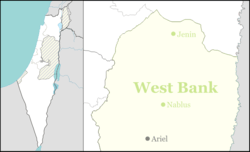Kedumim
Kedumim
| ||
|---|---|---|
| Hebrew transcription(s) | ||
| • ISO 259 | Qdumim | |
| • Also spelled | Qedumim (official) | |
|
| ||
| ||
 Kedumim | ||
| Coordinates: 32°12′55.98″N 35°9′30.03″E / 32.2155500°N 35.1583417°ECoordinates: 32°12′55.98″N 35°9′30.03″E / 32.2155500°N 35.1583417°E | ||
| Region | West Bank | |
| District | Judea and Samaria Area | |
| Founded | 1975 | |
| Government | ||
| • Type | Local council | |
| • Head of Municipality | Hananel Dorani | |
| Area | ||
| • Total | 2,313 dunams (2.313 km2 or 572 acres) | |
| Population (2015)[1] | ||
| • Total | 4,338 | |
Kedumim (Hebrew: קְדוּמִים), also Qedumim, is an Israeli settlement and town located in the Samarian hills of the West Bank. Founded on Hanukkah 1975 by members of the Gush Emunim settlement movement, it later became a local council. In 2015 it had a population of 4,338.
The international community considers Israeli settlements in the West Bank illegal under international law, but the Israeli government disputes this.[2][3][4]
History


In late 1974, a group affiliated with Gush Emunim named Garin Elon Moreh, led by Rabbi Menachem Felix and Benny Katzover, attempted to establish a settlement on the ruins of the Sebastia train station dating from the Ottoman period. An Israeli cabinet resolution, passed 17–2 with 3 abstentions, found the settlement illegal in 1975.[5] After several attempts to remove residents from the site by the Israel Defense Forces, an agreement was reached in which 25 families were permitted to settle in Kadum, an army camp southwest of Nablus. The small mobile home site developed into the town of Kedumim. The Sebastia agreement was a turning point that opened up the northern West Bank to Jewish settlement.
From 1977 on, the government of Menachim Begin strongly backed settlement at Kedumim. Begin visited on May 19 and declared "We stand on the land of liberated Israel."[5] In July, his government granted full legal status to Kedumim (then numbering around 100 settlers), Ofra, and Maaleh Adumim.[5]
Several residents of Kedumim have been killed in Palestinian political violence. Rabbi Binyamin Herling (64), a Holocaust survivor, was killed at Mount Ebal by Palestinian security forces and Fatah members who opened fire on a group of men, women, and children.[6] On May 30, 2006, a suicide bomber disguised as an Orthodox Jewish hitchhiker blew himself up inside a car that stopped to pick him up near the gas station at the entrance to the village.[7] The blast killed four Israelis - Rafi Halevy (63),[8] Helena Halevy (58),[9] Re'ut Feldman (20),[10] and Shaked Lasker (16).[11] Al-Aqsa Martyrs Brigades claimed responsibility. On November 19, 2007, Ido Zoldan (29) was killed in a shooting attack near Kedumim when Palestinian militiants opened fire on his car.[12]
Status under international law
The international community considers Israeli settlements a violation of the Fourth Geneva Convention.[13] Israel disputes that the Fourth Geneva Convention applies to these territories as they had not been legally held by a sovereign prior to Israel taking control of them. This view has been rejected by the International Court of Justice and the International Committee of the Red Cross.[14][15]
According to B'Tselem, portions of Kedumim were built on privately owned Palestinian land. There are additionally two Israeli outposts adjacent to Kedumim, one of which is also built on privately owned Palestinian land, according to B'tselem.[16]
Education
The residents of Kedumim have placed an emphasis on education and developed several local institutions, including: day care centers, kindergartens, two elementary schools, the Bnei Chayil Yeshiva, the Har Efrayim Yeshiva, the Lehava Ulpana High School (1000 girls), as well as a local music academy, and a public library.
Yeshivat Bnei Chayil Shomron is a high school yeshiva established in 1998[17] in order to provide an Orthodox Jewish education for boys with ADD and ADHD.[18] It is considered a unique facility in central Israel not limited to local students. Students in grades seven through twelve are divided into classes which are limited to a maximum of fifteen boys. The school in Kedumim was originally a branch of a Jerusalem school of the same name founded by Dr. Stuart Chesner.
Economy
While many residents work outside the village, many are employed locally in education as well as several agricultural enterprises working with greenhouses and orchards. The Bar-On Industrial Park on 1200 dunams (1.2 km²) of land is within the municipal boundaries of Kedumim. Kedumim (3000) is a local construction company.
Notable residents
See also
References
- ↑ "List of localities, in Alphabetical order" (PDF). Israel Central Bureau of Statistics. Retrieved 16 October 2016.
- ↑ "The Geneva Convention". BBC News. 10 December 2009. Retrieved 27 November 2010.
- ↑ Daniella Weiss: 62, mayor of the Jewish settlement of Kedumim, near Nablus, in the West Bank The Guardian, 4 June 2007
- ↑ Mass arrests create new foes for Israel The Guardian. 15 March 2002
- 1 2 3 Gerson, Allan (1978-09-28). Israel, the West Bank and International Law. Psychology Press. p. 150. ISBN 9780714630915.
- ↑ "Victims of Palestinian Violence and Terrorism since September 2000". GxMSDev.
- ↑ "Suicide bomber strikes in Kedumim". ynet.
- ↑ "Rafi Halevy". GxMSDev.
- ↑ "Helena Halevy". GxMSDev.
- ↑ "Re'ut Feldman". GxMSDev.
- ↑ "Shaked Lasker". GxMSDev.
- ↑ "Ido Zoldan". GxMSDev.
- ↑ The settlers' struggle BBC News. 19 December 2003
- ↑ Legal Consequences of the Construction of a Wall in the Occupied Palestinian Territory International Court of Justice, 9 July 2004. pp. 44-45
- ↑ Opinion of the International Court of Justice B'Tselem
- ↑ The settlement of Kedumim B'tselem 1 Jan 2011
- ↑ "ישיבת בני חיל - יום פתוח בח´ אלול 23/8/15". bnh.org.il.
- ↑ About the Yehsiva
External links
| Wikimedia Commons has media related to Kedumim. |
